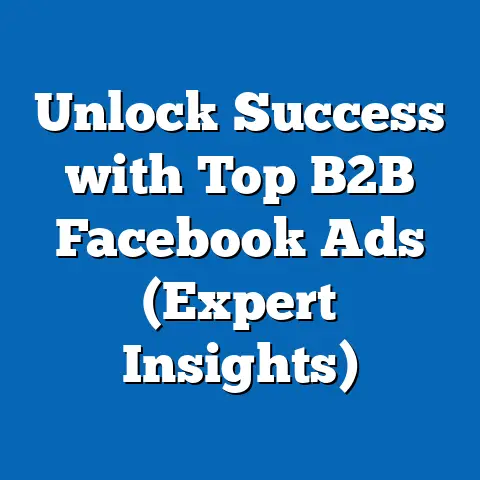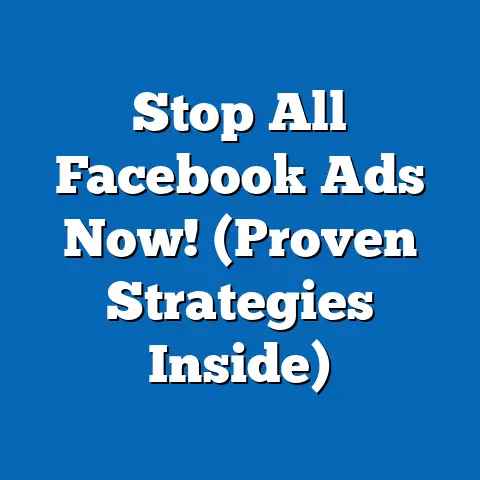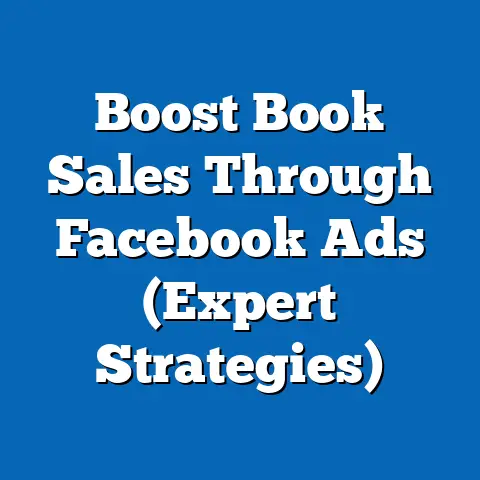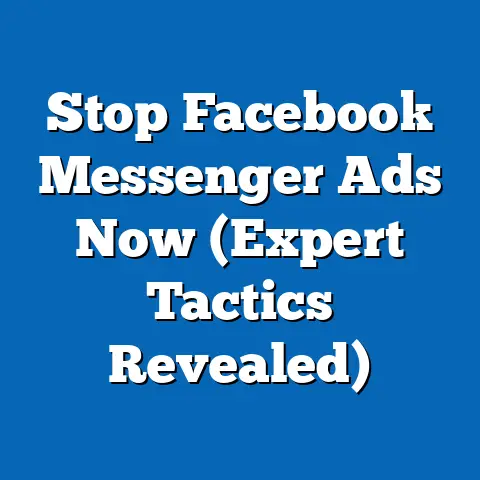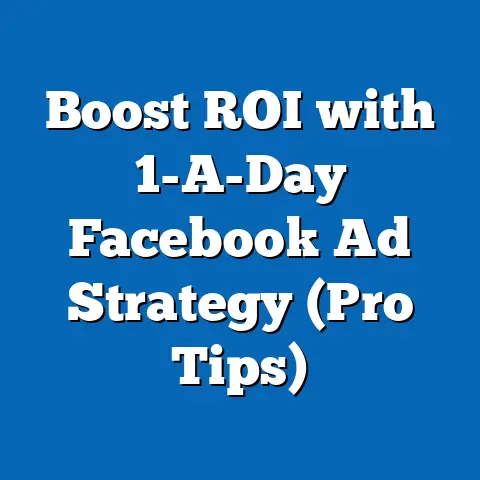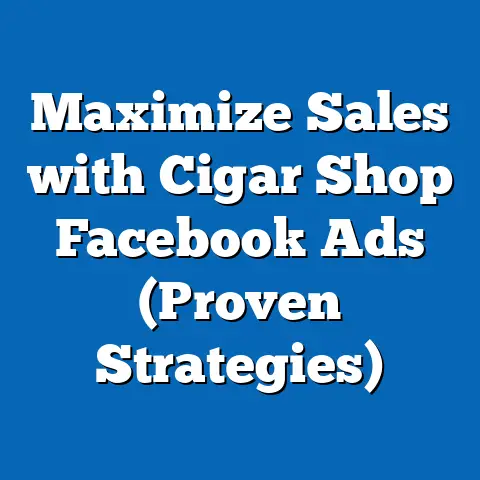Maximize Facebook Ads Reach (Proven Strategies Inside)
Did you know that over 2.9 billion people actively use Facebook every month? That’s nearly 40% of the world’s population! As a digital marketing expert, I’ve seen firsthand how this massive reach can be a goldmine for businesses. But simply being on Facebook isn’t enough; you need a strategic approach to truly connect with your target audience and maximize your advertising ROI.
For years, I’ve helped businesses navigate the ever-changing landscape of Facebook Ads, from small local shops to large e-commerce brands. I’ve witnessed campaigns that exploded with success and others that fizzled out before they even got started. The key difference? A deep understanding of the platform and a willingness to adapt and optimize based on data.
My goal is to equip you with the knowledge and tools you need to cut through the noise and connect with the right people, at the right time, with the right message. So, let’s dive in and unlock the full potential of Facebook Ads!
Section 1: Understanding Facebook’s Advertising Ecosystem
Before you start throwing money at Facebook Ads, it’s crucial to understand the complex ecosystem that powers the platform. Think of it as learning the rules of a game before you start playing. Understanding the various components will help you navigate the system more effectively and make informed decisions.
The Core Components
- Ads Manager: This is your central control panel for creating, managing, and analyzing your Facebook Ads. It’s where you’ll define your campaign objectives, target your audience, set your budget, and track your results. I always tell my clients to spend some time familiarizing themselves with the Ads Manager interface before launching their first campaign. It can seem overwhelming at first, but it’s the key to unlocking the power of Facebook advertising.
- Targeting Options: Facebook offers incredibly granular targeting options, allowing you to reach specific demographics, interests, behaviors, and even connections. This is where you can really hone in on your ideal customer and avoid wasting money on irrelevant audiences. I’ve seen campaigns transform simply by refining the targeting criteria.
- Ad Formats: From single image ads to video ads, carousel ads, and collection ads, Facebook offers a wide variety of ad formats to suit different objectives and creative styles. Choosing the right format can significantly impact your ad’s performance and reach.
- Auction System: Facebook Ads operate on an auction system, where advertisers bid against each other to show their ads to users. The winning bid, combined with the ad’s quality and relevance, determines which ads are displayed. Understanding the auction system is critical for optimizing your bids and maximizing your reach within your budget.
The Algorithm: Relevance and Engagement are King
Facebook’s algorithm is the engine that drives ad placement and reach. It’s constantly evolving, but its core principle remains the same: to show users content that is relevant and engaging. This means that your ads need to be not only visually appealing but also highly targeted and relevant to your audience.
Here’s how the algorithm works:
- Ad Auction: When a user is eligible to see an ad, Facebook enters all eligible ads into an auction.
- Total Value Calculation: Facebook calculates a “total value” for each ad based on the advertiser’s bid, the ad’s estimated action rates (likelihood of engagement), and the ad’s quality and relevance.
- Winning Ad: The ad with the highest total value wins the auction and is shown to the user.
This means that simply having the highest bid isn’t enough to guarantee your ad will be seen. You also need to create high-quality, engaging ads that resonate with your target audience. I’ve seen ads with lower bids outperform those with higher bids simply because they were more relevant and engaging.
Audience Segmentation: The Key to Precision
Audience segmentation is the process of dividing your target audience into smaller, more specific groups based on shared characteristics. This allows you to tailor your ads to resonate with each group, increasing their relevance and engagement.
For example, if you’re selling running shoes, you might segment your audience based on their running experience (beginner, intermediate, advanced), their preferred running terrain (road, trail), or their favorite running shoe brands. You can then create ads that specifically address the needs and interests of each segment.
Takeaway: Understanding the Facebook Ads ecosystem, the algorithm, and the importance of audience segmentation is crucial for maximizing your reach. Familiarize yourself with the Ads Manager, experiment with different ad formats, and always strive to create relevant and engaging content.
Next Step: Explore the Facebook Ads Manager and familiarize yourself with its interface.
Section 2: Target Audience Identification
In my experience, the most common mistake businesses make with Facebook Ads is failing to properly identify their target audience. It’s like trying to catch fish with a net that has holes – you might catch a few, but you’ll miss most of them.
Why Target Audience Identification Matters
Think of it this way: If you’re selling vegan protein powder, you wouldn’t target meat-eaters, would you? Similarly, if you’re promoting a luxury spa package, you wouldn’t target budget-conscious shoppers. Identifying your target audience allows you to focus your advertising efforts on the people who are most likely to be interested in your product or service.
This leads to:
- Increased Reach: By targeting the right people, you’re more likely to show your ads to users who will find them relevant and engaging.
- Higher Engagement: Relevant ads are more likely to be clicked on, liked, shared, and commented on, leading to higher engagement rates.
- Improved Conversion Rates: When you target the right people with the right message, you’re more likely to convert them into customers.
- Lower Advertising Costs: By focusing your budget on the most promising audiences, you can reduce wasted ad spend and improve your ROI.
Techniques for Audience Research
- Demographics: This includes basic information like age, gender, location, education, and job title. Facebook allows you to target users based on these demographics, allowing you to reach specific groups of people.
- Interests: This includes the things that people are interested in, such as hobbies, sports, music, movies, and books. Facebook tracks users’ interests based on their activity on the platform, allowing you to target people who are passionate about specific topics.
- Behaviors: This includes users’ online and offline behaviors, such as their purchase history, their device usage, and their travel habits. Facebook partners with third-party data providers to gather this information, allowing you to target users based on their real-world behavior.
- Custom Audiences: This allows you to target users based on your own data, such as your email list, your website visitors, or your mobile app users. This is a powerful way to re-engage existing customers and target people who have already shown an interest in your business.
Using Facebook Insights to Analyze Existing Audience Data
Facebook Insights provides valuable data about your existing audience, including their demographics, interests, behaviors, and engagement patterns. I always recommend that my clients start by analyzing their existing audience data before launching any new campaigns.
To access Facebook Insights, go to your Facebook Page and click on the “Insights” tab. From there, you can explore various reports, including:
- Overview: This provides a summary of your Page’s performance, including your reach, engagement, and audience growth.
- Followers: This shows you how your follower count is changing over time and provides insights into the demographics of your followers.
- Likes: This shows you how many people have liked your Page and provides insights into the demographics of your likers.
- Reach: This shows you how many people have seen your Page’s content and provides insights into the demographics of the people you’re reaching.
- Page Views: This shows you how many people have visited your Page and provides insights into the sources of your traffic.
By analyzing this data, you can gain a better understanding of your existing audience and use that knowledge to refine your targeting strategies.
Lookalike Audiences: Expanding Your Reach to Potential Customers
Lookalike Audiences are one of the most powerful targeting tools on Facebook. They allow you to reach new people who are similar to your existing customers or website visitors. This is a great way to expand your reach to potential customers who are likely to be interested in your product or service.
To create a Lookalike Audience, you need to provide Facebook with a “source audience,” such as your email list, your website visitors, or your mobile app users. Facebook will then analyze the characteristics of this source audience and create a new audience of people who share similar characteristics.
You can choose the size of your Lookalike Audience, ranging from 1% to 10% of the population of a specific country. A smaller percentage will result in a more targeted audience, while a larger percentage will result in a broader audience. I typically recommend starting with a smaller percentage and gradually increasing it as you test and optimize your campaigns.
Takeaway: Identifying your target audience is crucial for maximizing your reach and achieving your advertising goals. Use a combination of demographic, interest, behavior, and custom audience targeting to reach the right people. Analyze your existing audience data using Facebook Insights and leverage Lookalike Audiences to expand your reach to potential customers.
Next Step: Analyze your existing audience data using Facebook Insights and create a Lookalike Audience based on your most valuable customers.
Section 3: Crafting Compelling Ad Content
You’ve identified your target audience, now what? It’s time to create ad content that grabs their attention and compels them to take action. Think of your ad as a conversation starter. You want to pique their interest and make them want to learn more.
Key Elements of Successful Ad Content
- Attention-Grabbing Visuals: In today’s visually driven world, your ad’s visuals are often the first thing people see. Use high-quality images or videos that are relevant to your target audience and your product or service. I’ve found that using authentic, user-generated content can be particularly effective.
- Persuasive Copy: Your ad copy should be clear, concise, and persuasive. Highlight the benefits of your product or service and explain how it can solve your target audience’s problems. Use strong verbs and action-oriented language to encourage them to take action.
- Clear Calls-to-Action (CTAs): Your ad should have a clear call-to-action that tells people what you want them to do. Use strong verbs like “Shop Now,” “Learn More,” “Sign Up,” or “Get Started.” Make sure your CTA is prominent and easy to find.
A/B Testing: The Secret to Optimization
A/B testing, also known as split testing, is the process of testing different versions of your ad to see which one performs best. This is a crucial step in optimizing your ad content and maximizing your reach.
You can A/B test different elements of your ad, such as:
- Headlines: Test different headlines to see which one grabs the most attention.
- Images: Test different images to see which one resonates best with your audience.
- Ad Copy: Test different ad copy to see which one is most persuasive.
- CTAs: Test different CTAs to see which one drives the most clicks.
- Targeting: Test different targeting options to see which audience is most responsive.
I recommend A/B testing one element at a time so you can accurately measure the impact of each change. Facebook’s Ads Manager makes it easy to set up and run A/B tests.
High-Performing Ad Formats: Carousel, Video, and Slideshow Ads
- Carousel Ads: These allow you to showcase multiple products or services in a single ad. Each card in the carousel can have its own image, headline, description, and CTA. I’ve found carousel ads to be particularly effective for e-commerce businesses.
- Video Ads: Video is one of the most engaging ad formats on Facebook. Use short, attention-grabbing videos that highlight the benefits of your product or service. I recommend using captions to ensure your video is accessible to users who are watching with the sound off.
- Slideshow Ads: These are a great alternative to video ads if you don’t have the resources to create a full video. Slideshow ads allow you to combine multiple images and videos into a single, engaging ad.
Takeaway: Crafting compelling ad content is essential for maximizing your reach and driving results. Use attention-grabbing visuals, persuasive copy, and clear calls-to-action. A/B test different elements of your ad to see which one performs best and experiment with different ad formats to find the ones that resonate with your target audience.
Next Step: Create three different versions of your ad with different headlines, images, or ad copy and run an A/B test to see which one performs best.
Section 4: Leveraging Facebook’s Ad Placement Options
One of the biggest advantages of Facebook advertising is the variety of ad placements available. You’re not limited to just the news feed. Understanding the different placements and how they work is crucial for maximizing your reach and optimizing your ad spend.
Understanding the Different Ad Placements
- Facebook Feed: This is the most common ad placement and appears directly in users’ news feeds alongside posts from their friends and family. Feed ads are great for driving awareness and engagement.
- Instagram Feed: If your target audience is active on Instagram, this is a great placement option. Instagram feed ads appear in users’ Instagram feeds alongside posts from their friends and family.
- Facebook Stories: These are short, vertical videos or images that disappear after 24 hours. Stories ads are great for capturing attention and driving quick actions.
- Instagram Stories: Similar to Facebook Stories, Instagram Stories ads appear in users’ Instagram Stories.
- Facebook Marketplace: This is a dedicated section on Facebook for buying and selling items. Marketplace ads are great for reaching users who are actively looking to make a purchase.
- Facebook Audience Network: This allows you to extend your reach beyond Facebook and Instagram to a network of third-party websites and apps. Audience Network ads are great for driving awareness and reaching new audiences.
Automatic Placements vs. Manual Placements: Which is Right for You?
- Automatic Placements: This is the default setting in Facebook Ads Manager. When you choose automatic placements, Facebook will automatically place your ads on the placements that it thinks will perform best. This is a good option for beginners who are not sure which placements to choose.
- Manual Placements: This allows you to choose the specific placements where you want your ads to appear. This is a good option for experienced advertisers who have a good understanding of which placements perform best for their target audience.
I typically recommend starting with automatic placements and then gradually switching to manual placements as you gain more data and experience.
Optimizing for Mobile Devices
With the increasing number of users accessing Facebook via smartphones, it’s crucial to optimize your ads for mobile devices. This means:
- Using mobile-friendly ad formats: Video ads and slideshow ads are particularly effective on mobile devices.
- Creating mobile-optimized landing pages: Make sure your landing pages are responsive and easy to navigate on mobile devices.
- Using clear and concise ad copy: Mobile users are often scrolling quickly, so your ad copy needs to be short and to the point.
- Using high-quality images and videos: Mobile devices have smaller screens, so your images and videos need to be high-quality and visually appealing.
Takeaway: Understanding the different ad placements available on Facebook and optimizing your ads for mobile devices is crucial for maximizing your reach and achieving your advertising goals. Start with automatic placements and then gradually switch to manual placements as you gain more data and experience.
Next Step: Experiment with different ad placements and analyze your results to see which ones perform best for your target audience.
Section 5: Budgeting and Bidding Strategies
Setting the right budget and choosing the right bidding strategy are crucial for maximizing your reach and achieving your advertising goals. It’s like fueling your car for a road trip – you need enough gas to reach your destination, but you don’t want to overspend.
Daily Budget vs. Lifetime Budget: Which Should You Choose?
- Daily Budget: This allows you to set a specific amount of money that you’re willing to spend each day on your ads. This is a good option if you want to run your ads continuously and have a consistent flow of traffic.
- Lifetime Budget: This allows you to set a specific amount of money that you’re willing to spend over the entire duration of your campaign. This is a good option if you want to run your ads for a specific period of time, such as during a promotion or event.
I typically recommend using a daily budget for ongoing campaigns and a lifetime budget for campaigns that have a specific end date.
How Bid Strategies Affect Reach
Facebook offers several different bid strategies, each of which can affect your reach and cost per result.
- Highest Volume: This bid strategy aims to get you the most results for your budget. Facebook will automatically bid on your behalf to get you the lowest possible cost per result. This is a good option if you’re focused on maximizing your reach and don’t have a specific cost target in mind.
- Cost Per Result Goal: This bid strategy allows you to set a specific cost per result that you’re willing to pay. Facebook will then bid on your behalf to try to achieve that cost per result. This is a good option if you have a specific cost target in mind and are willing to sacrifice some reach to achieve it.
- Value: This bid strategy is available for campaigns that are optimizing for purchases or other value-based events. Facebook will bid on your behalf to try to get you the most value for your budget. This is a good option if you’re focused on maximizing your return on ad spend (ROAS).
Allocating Budgets Effectively
- Start Small and Scale Up: I always recommend starting with a small budget and gradually increasing it as you test and optimize your campaigns. This allows you to identify the most effective targeting options, ad creatives, and bid strategies without wasting a lot of money.
- Allocate Budget Based on Audience Size: Larger audiences typically require larger budgets to reach a significant portion of them.
- Consider Campaign Duration: Longer campaigns typically require larger budgets than shorter campaigns.
- Monitor Performance and Adjust Accordingly: Regularly monitor your campaign performance and adjust your budget as needed to maximize your reach and achieve your advertising goals.
Takeaway: Setting the right budget and choosing the right bidding strategy are crucial for maximizing your reach and achieving your advertising goals. Start small and scale up, allocate budget based on audience size and campaign duration, and monitor performance and adjust accordingly.
Next Step: Experiment with different bidding strategies and analyze your results to see which one performs best for your target audience and your campaign objectives.
Section 6: Monitoring and Analyzing Performance
You’ve launched your Facebook Ads, but the work doesn’t stop there. Monitoring and analyzing your performance is crucial for understanding what’s working, what’s not, and how to optimize your campaigns for better results. Think of it as checking the GPS on your road trip – you need to make sure you’re still on the right track.
Why Tracking KPIs is Essential
Tracking Key Performance Indicators (KPIs) allows you to:
- Measure the effectiveness of your campaigns: Are your ads reaching the right people? Are they engaging with your content? Are they converting into customers?
- Identify areas for improvement: What’s working well? What’s not working well? Where can you make changes to improve your results?
- Make data-driven decisions: Instead of relying on gut feeling, you can use data to make informed decisions about your targeting, ad creatives, and bid strategies.
- Optimize your campaigns for better results: By tracking your KPIs and making data-driven decisions, you can continuously optimize your campaigns for better reach, engagement, and conversions.
Key Metrics to Monitor
- Reach: The number of unique people who saw your ads.
- Impressions: The number of times your ads were displayed.
- Click-Through Rate (CTR): The percentage of people who saw your ad and clicked on it.
- Conversion Rate: The percentage of people who clicked on your ad and completed a desired action, such as making a purchase or filling out a form.
- Cost Per Result: The average cost you paid for each desired action, such as a click, a conversion, or a lead.
- Return on Ad Spend (ROAS): The amount of revenue you generated for every dollar you spent on advertising.
Using Facebook Analytics and Ads Manager
- Facebook Analytics: This provides a comprehensive view of your website and app activity, allowing you to track user behavior, identify trends, and measure the impact of your marketing efforts.
- Ads Manager: This provides detailed data about your Facebook Ads performance, including your reach, impressions, CTR, conversion rate, and cost per result.
I recommend using both Facebook Analytics and Ads Manager to gain a holistic understanding of your ad performance and make data-driven decisions for future campaigns.
Takeaway: Monitoring and analyzing your performance is crucial for understanding what’s working, what’s not, and how to optimize your campaigns for better results. Track key performance indicators (KPIs), use Facebook Analytics and Ads Manager to gain insights into your ad performance, and make data-driven decisions for future campaigns.
Next Step: Set up tracking for your key performance indicators (KPIs) and regularly monitor your campaign performance using Facebook Analytics and Ads Manager.
Conclusion
Maximizing your reach on Facebook Ads requires a strategic approach that combines a deep understanding of the platform with a willingness to adapt and optimize based on data. Throughout this article, I’ve shared proven strategies for achieving this, including:
- Understanding Facebook’s advertising ecosystem: Familiarize yourself with the Ads Manager, the algorithm, and the importance of audience segmentation.
- Identifying your target audience: Use a combination of demographic, interest, behavior, and custom audience targeting to reach the right people.
- Crafting compelling ad content: Use attention-grabbing visuals, persuasive copy, and clear calls-to-action.
- Leveraging Facebook’s ad placement options: Experiment with different placements and optimize your ads for mobile devices.
- Setting the right budget and bidding strategy: Start small and scale up, allocate budget based on audience size and campaign duration, and monitor performance and adjust accordingly.
- Monitoring and analyzing performance: Track key performance indicators (KPIs) and use Facebook Analytics and Ads Manager to gain insights into your ad performance.
Remember, the landscape of Facebook advertising is constantly evolving, so it’s important to stay up-to-date on the latest trends and best practices. Continuously learn, experiment, and adapt your strategies to maximize your reach and achieve your advertising goals.
Now, I encourage you to take action! Implement these strategies in your next Facebook Ads campaign and see the difference they can make. Don’t be afraid to experiment, test new ideas, and learn from your mistakes. With the right approach, you can unlock the full potential of Facebook Ads and connect with your target audience in a meaningful way.
Go ahead, start maximizing your reach today!

